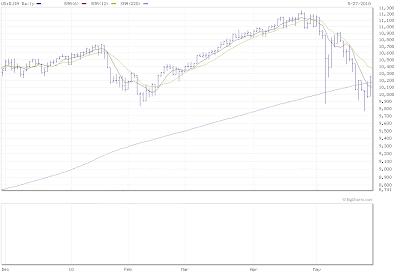Another good week. Scaled down stock shorts to 2.5%-5% and turned out very well, made good money on short silver and long bonds. They were all related so it's like going to a party and kissing sisters. They all taste similar to each other. This uniformity of markets is unusual and not to be expected once the world deflates the extraordinary stimulus created by desperate pols. This deflation will occur naturally in the markets, so the lower the stock market goes the less it will correlate with commodities, currencies, and bonds. Expect this and ease this correlation out of trading strategies that you may employ.
I expect the rally started Friday to continue Monday. In the afternoon I intend to practice scale-up shorting, hoping that the market gets all the way to the 5-minute, 380-unit M/A. By the afternoon this should decline to the 10,270 area. This analysis is consistent both with the I1 peak at the close Monday, but with the wave count.
I have been posting wave counts more assiduously in the past few days. There is a reason for this, a good one, which is that we are in wave (v) from the 4/26 high. While I expect stocks to decline into the 6/8 I1 low the behavior after it violates the flash crash low 9872 will be spasmodic, perhaps chaotic. It will be difficult to maintain inner peace unless one also maintains sharp focus. This downleg of the I1 may encompass a sharp rally correcting the decline from 4/26 BEFORE going on to new low 6/8. This is because we are in wave iv of (v), in other words what appears to be the late stages. Wave (v) could extend, in which case the I1 will mirror the steady decline of the stock market into the 6/8 low. An accurate count will allow me to determine if an extension is in the cards. The rally off of the wave (v) low should be striking if and when it comes and any error in timing will be magnified. So, just bear with me as I post the wave count charts one more time:


Notice the 220-day M/A in the first chart. Bouncing off of this should continue through Monday.
I have a confession. I lost money for 10 years and broke even for 3 before turning it around. I've recouped more than I lost so I count myself fortunate.
The point I am trying to make is that the gains look easy but, believe me, they are not. Those of you contemplating a life as a trader should examine the probabilities. 90% lose, simple as that. I continued on because I'm, well, soft in the head.
I have made a commitment to myself to continue this blog for another year. I ask that those using this blog to guide their decisions follow conservative money management. I use very conservative capital allocations because I want to impress upon readers the importance of keeping it small and generating gains consistently with very small drawdowns. I also use conservative allocations because my capital base is larger than it was a few years ago. I know how it is when trading with capital less than $50,000. There is a strong tendency to plunge. Let's look at it mathematically. With $50,000 and a 15% allocation to double-short ETFs the amount of stock controlled is $15,000. A 5% return on a trade is $750. To an inexperienced trader this may not seem worth the effort. Believe me, it is. Compounding works wonders, but compounding is utterly defeated by a single large drawdown.
So, for my purposes a 5% allocation is all that I warrant for my personal accounts on a longer-term trade and a 15% allocation is all that I warrant on a short-term trade (in the direction of I1). Those without deep pockets can double those allocations safely and, rather than plunge, that is what I would recommend. I am happy to provide the results of my research and experience. I ask only that you allow compounding to work by not going "all in".
My trading history over the past several years is to tread water 26 weeks out of the year and make good money the remaining 26. However, those 26 generate an excellent return for the year. To see how excellent the Trading History page is an Excel spreadsheet. Those that have followed the blog from the beginning pretty much know how it goes.

















































